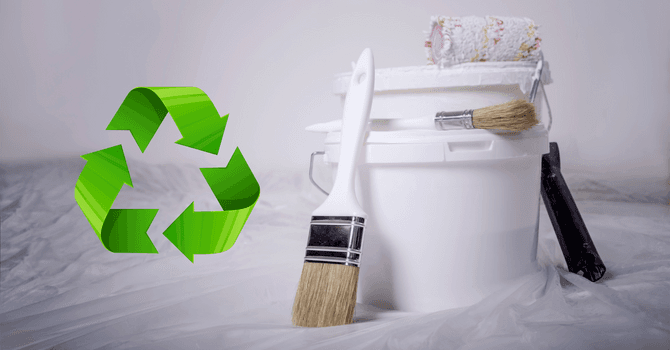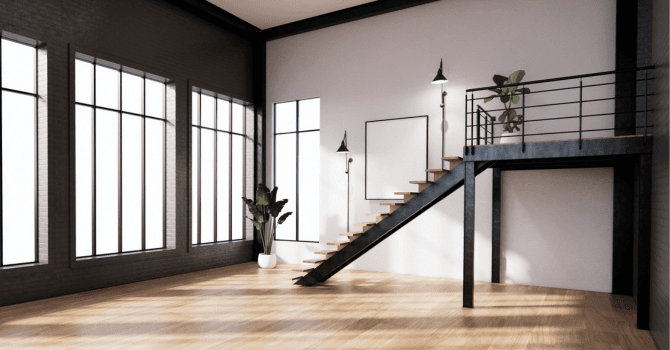
To embrace a green lifestyle, a lot of homeowners are choosing to use so-called zero-VOC paint when it comes time to renovate the walls of their dwellings. However, what they don’t know is that, in fact, most presumed 100% “green” paint isn’t entirely as such. Therefore, you have to be careful when purchasing eco-friendly paint. In our article, you’ll find all the information you need to make an informed choice.
What’s Zero-VOC Paint?

Source: Canva
Zero- or no-VOC paint is a product that’s made with natural ingredients, that’s eco-friendly and free of health hazards. This type of paint doesn’t emit Volatile Organic Compounds (VOC) and is considered organic paint. It’s odourless and doesn’t contain any formaldehyde. Zero-VOC paint is thereby ideal for enhancing air quality in a home or building. Just like traditional paint, it’s available in several shades and colours. You can match your interior wall colours according to personal preferences.
Volatile Organic Compounds
Keep in mind that VOCs or Volatile Organic Compounds are volatile chemical products added to paint to prolong shelf life and improve freeze-thaw resistance. When the paint dries, these particles are released through toxic gaseous elements that spread into the air for several weeks or several months before permeating fabrics.
There are several types of VOCs, some are more harmful than others. They’re a health hazard when inhaled and can spoil air quality. Therefore, it’s best to exclude them as often as possible from your living quarters.
Amongst the most common VOCs, we’ve listed the following:
Formaldehyde;
Benzene;
Toluene;
Gas;
Fuels;
Alcohols;
Organic solvents.
These can cause nausea, dizziness, nose and throat irritation, fatigue, and many other symptoms. VOCs are responsible for global warming and contribute to air pollution. They’re found in paint, but also in numerous cleaning products, furniture, particleboards, beauty products, toys, etc. Oftentimes, these products are made with heavy metal pigments, which can be a significant source of pollution.
However, zero-VOC paint contains a very low level of Volatile Organic Compounds, since no solvents are used during the manufacturing process. Instead, plant oils, water, and plant dyes are used, amongst other natural ingredients. Naturally, it’s difficult to obtain a 100% natural product since in the end, some petrol by-products are used during the manufacturing process of low- or so-called zero-VOC paint, albeit, the amount is much less significant than that of conventional products.
“Green” and low-odour paints emit very little, thus, they’re considered eco-friendly.
Zero-VOC Paint…Isn’t Always VOC-Free
Since the VOC Concentration Limits for Certain Products Regulations were passed in 2010, a lot of brands have since labelled their paint cans with “low-VOC” or “zero-VOC.” Yet, one can’t trust all green labels such as “organic” or “eco-friendly.” A lot of these labels and green labels are misleading. The “zero-VOC” or "No-VOC" label doesn’t mean the product doesn’t contain any Volatile Organic Compounds like it would lead us to believe, but more so that the paint doesn’t contain as much as it did prior to the regulations.
And, in some Canadian provinces, one can find low- or zero-VOC labelled paint that actually does contain toxic chemicals. In fact, very few contain less than 5 g/L. Furthermore, the majority of manufacturers determine the concentration of Volatile Organic Compounds in paint without taking into account the emissions produced by pigments added to the base colour. Generally speaking, the darker the pigment, the more toxic chemicals it contains. Thus, zero-VOC or low-VOC paint is definitely less harmful, but it’s still made with petrochemically-processed ingredients.
The Canadian Paint and Coatings Association states that the maximum VOC level permitted in Canada is 150 grams per litre for white interior paint and 250 g/L for select household products such as concrete floor coatings, direct-to-metal paint, etc.
Zero-VOC products do exist, but they’re rare. The majority of paint cans labelled with the “zero-VOC” or “no-VOC” claim contain at least 4 to 5 g/L.
In Canada, regulating the content of organic and volatile paint compounds isn't yet set in stone, which allows some manufacturers to easily bend the rules. Environment Canada doesn’t monitor the “zero-VOC” or any of its varying labels. Every manufacturer follows their own set of rules. In other words, brands aren’t required to indicate the amount of VOC inside the paint, but if they do, they're solely required to specify the amount found in the white base colour, before any pigment is added. This information is usually mentioned in the product’s user guidelines. And, looking over the list of ingredients doesn’t always come in handy since it’s more often than not incomplete and there are so many different Volatile Organic Compounds that it’s hard to recognize them all.
Zero-VOC Paint Characteristics
In order for a manufacturer to label their paint as natural, meaning without VOC emissions, their product must comply with a set of requirements as outlined by the Federal Trade Commission (FTC). There must be concrete evidence proving that the paint only has trace emission levels within six hours of its application. They must also provide proof that the paint contains no compounds susceptible to causing the average adult health issues as a result of normal, intended use.
Some characteristics of no-VOC paint:
Diffuses water and vapour;
Doesn’t contain solvents, harmful dryers, or petroleum-based products;
Available in white, but can be dyed with various colours;
Resistant and has a good service life;
Static guard;
It can’t be applied outside and is reserved for indoor use only since it doesn’t contain any petroleum or alkyd-type products;
Can be diluted with water;
Available in various versions depending on the type of surface to cover: cement, wood, plaster, fibreglass, etc.
In terms of efficiency, eco-friendly paints have the same performance levels as conventional paints. They’re excellent in terms of coverage and are mould- and water-resistant. It also withstands impacts, but if you plan on painting over a specific surface or often-used furniture, it’s best to opt for high-end, zero-VOC paint. Low-end products are more likely to be marked by impacts. Nonetheless, note that some products, even when complying with regulations, do contain a significant amount of VOCs to be efficient and resistant. The latter is especially seen with concrete floor coatings, rust-resistant exterior steel paint or with primers.
Eco-friendly paints are more expensive than traditional paints. Their manufacturing process requires the use of high-end resin and more stringent manufacturing procedures.
How to Recognize “Green” Paint and Limit VOC Use in Homes

Source: Canva
In Canada, it’s rather difficult to find zero- or low-VOC paint. The plethora of products available on the market can be confusing. While a lot of brands do offer health-safe products, very few actually comply with this marketing pitch in their formulations. Here are a few helpful tips for choosing the most eco-friendly paint possible and limiting Volatile Organic Compounds in homes:
Even though it can’t guarantee anything, check the product label before purchasing, that way, you’ll be able to choose a low-VOC paint.
Ask the sales clerk questions, they’ll be able to help you make the right decision.
Opt for urea-formaldehyde-free particleboard products such as plywood, MDF, etc.
Make sure to choose paint and polish with low-VOC emissions.
Opt for water-based sealers with low toxicity levels.
Favour pre-owned furniture or solid wood since they don’t contain any volatile organic compounds. Through the years (about 5 years), the furniture will already have emitted any of the VOCs they contained. To renovate your old furniture, pay attention to the type of stain or polish you’ll use.
Avoid latex-made carpets and favour cotton or wool models instead. When it comes to installation, avoid using glue, and use nails.
Focus on solvent-free products and be sure to choose a sanitizing paint that can capture formaldehyde pollutants and “clean” the ambient air.
Always follow the manufacturer’s instructions: Don’t just mix two products together, don’t inhale fumes, etc.
Examples of Zero-Volatile Organic Compound Paints Available in Canada
Here’s a brief list of zero Volatile Organic Compound paints retailed in Canada:
Benjamin Moore’s Eco Spec: Zero-VOCs nor emissions, this product is ideal if you’re looking for a “green” interior paint. It’s 100% acrylic and it holds up really well. Gennex patented VOC-free colourants guarantee zero VOC content, even after colourants are added. On top of that, it dries really fast and is certified Green Seal. Plan to spend about $68.18 for a 3.79 L can.
Benjamin Moore’s Natura: This is a high-end brand of paint that doesn’t emit VOCs. It’s 100% acrylic and its use is recommended in children’s bedrooms. In other words, this paint is eligible for the LEED certification program. It’s yours starting at $74.99 a gallon.
Boomerang’s recycled and latex-based interior paint: It’s super easy to apply and provides great coverage. It’s certified low-VOC, which guarantees its low levels of VOC. It emits less than four times the amount of greenhouse gases as conventional paints. It costs about $23.99 for a 3.78 L can.
LifeTime-Wood Treatment: This is powdered stain formula that’s mixed with water. It costs about $18.95 per 20 g for 4.5 L of the finished product.
No-VOC Paint: A Few Pointers
Albeit natural paints have a low VOC, we still recommend airing out the room while and after applying the paint (for 2 to 3 days). During this lapse of time, paint usually emits more Volatile Organic Compounds. Remember to wear a mask while applying the paint.
In a newly renovated or built home, VOCs can persist for months, years even. Therefore, airing out the rooms twice a day is crucial.
The use of a washable matte version of eco-friendly paint is reserved for dry areas of a home, whereas the silky smooth washable version should be applied in humid rooms (walls, ceilings). It’s applied in two layers, and the drying time between the two coats is usually 6 hours. Altogether, it’s about 24 hours of drying time.
Get 3 renovation quotes for your painting project
RenoQuotes.com can help you get quotes for your painting project. By submitting your project, we’ll put you in contact with top-rated contractors. Fill in the form on the homepage (it only takes a few minutes) and get estimates from trusted professionals.
Dial 1-844 828-1588 to speak with one of our customer service representatives.
Looking for something else?
Related articles
The latest industry news, interviews, technologies, and resources.

Karine Dutemple
•05 Dec 2025
With summer at our feet, one can't help but quickly take out their lounge chairs and outdoor patio furniture to make the most out of the nice weather. While you may be barbecue ready, your patio, on the other hand, might need a bit more TLC!

Editorial Team
•23 Feb 2024
For a few years now, Boomerang Paint has been increasingly solicited for interior renovation and decoration projects. The reason being its green characteristics and excellent value for money. If you’re looking for eco-friendly interior paint, opting for recycled paint is the best decision you can make. Learn all about this type of product in the following section.

Editorial Team
•07 Nov 2023
Are you curious about changing the layout of your mezzanine to improve the design of this living space, and are looking for some ideas before you begin this project? Take a peek at these wonderful examples of mezzanines to offer you some inspiration.

Editorial Team
•16 May 2024
Eco-paving is a technique that consists of paving road surfaces with recycled rubber instead of asphalt. Learn more about eco-paving, as well as its advantages, cost, and eco-friendly nature so that you can use it with complete confidence.

Editorial Team
•24 Sep 2024
Ceramic tile flooring has a slew of advantages. Not only is it a resilient and long-lasting material, but it also requires minimal maintenance and is likely to increase the value of your home.